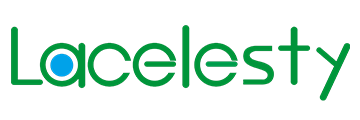When choosing LED lamps, it’;s important to consider the IP class, or degree of protection against solid objects and liquids. In this article, we’;ll discuss what IP classes are and how to choose the right one for your needs.
What Is an IP Rating?
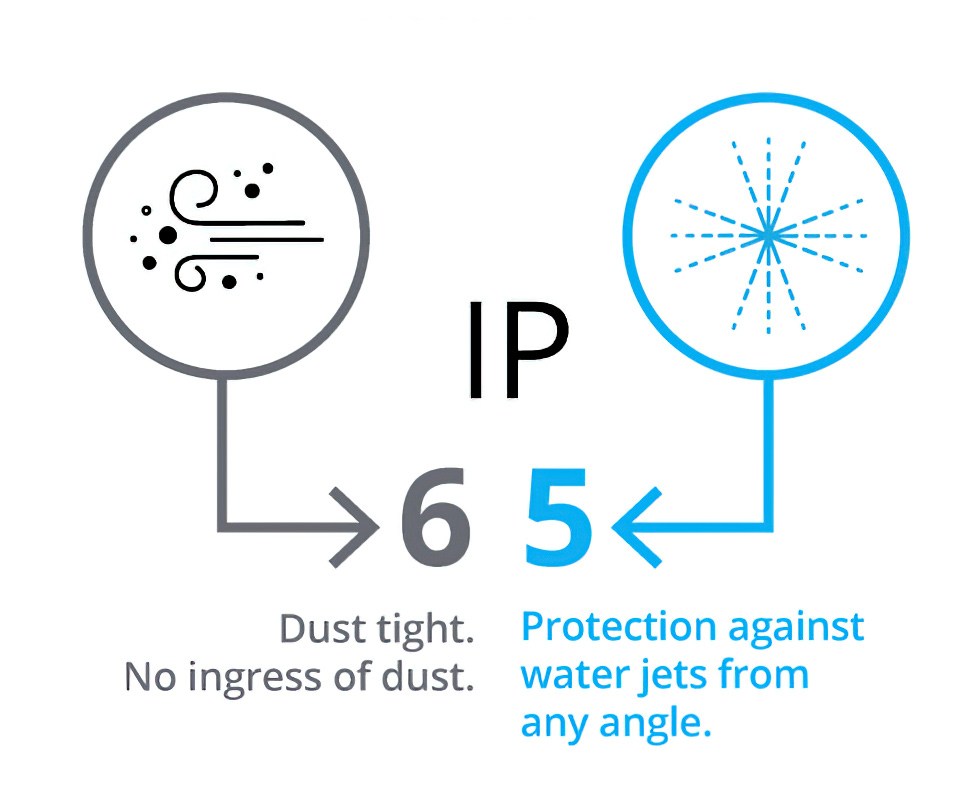
IP is an acronym for Ingress Protection. IP rating is the ability to prevent foreign objects from entering the enclosure of electrical equipment. It comes from the standard IEC 60529 of the International Electrotechnical Commission. This international standard gives you an idea of how well a lamp (or other item) is sealed from moisture and dust. IPXX, where XX is two Arabic numerals, the first number represents the level of protection against solid objects, the highest level is 6; the second number indicates the waterproof level, the highest level is 8, the larger the number, the better the protection level.
;
What do the two digits in an IP Rating mean?
The rating consists of the letters IP followed by two digits, the higher the number the better the protection.
First Digit: Solid
The first digit in the IP Code classification indicates the level of protection the enclosure provides against access to hazardous parts and the ingress of solid foreign objects.
| Level | Object size protected against | Effective against |
0 | Not protected | No protection against contact and ingress of objects |
1 | >;50mm | Any large surface of the body, such as the back of the hand, but no protection against deliberate contact with a body part. |
2 | >;12.5mm | Fingers or similar objects. |
3 | >;2.5mm | Tools, thick wires, etc. |
4 | >;1mm | Most wires, screws, etc. |
5 | Dust Protected | Ingress of dust is not entirely prevented, but it must not enter in sufficient quantity to interfere with the satisfactory operation of the equipment; complete protection against contact. |
6 | Dust Tight | No ingress of dust; complete protection against contact. |
Second digit: liquid
Protect the device inside the enclosure from the ingress of harmful water.
| Level | Object size protected against | Effective against |
0 | Not protected | –; |
1 | Dripping water | Dripping water (vertically falling drops) shall have no harmfull effect. |
2 | Dripping water (vertically falling drops) shall have no harmfull effect. | Vertically dripping water shall have no harmful effect when the enclosure is tilted at an angle up to 15° from its normal position. |
3 | Spraying water | Water falling as a spray at any angle up to 60° from the vertical shall have no harmful effect. |
4 | Splashing water | Water splashing against the enclosure from any direction shall have no harmful effect. |
5 | Water projected by a nozzle (6.3mm) against enclosure from any direction shall have no harmful effects. | Water projected by a nozzle (6.3mm) against enclosure from any direction shall have no harmful effects. |
6 | Powerful water jets | Water projected in powerful jets (12.5mm nozzle) against the enclosure from any direction shall have no harmful effects. |
7 | Immersion up to 1m | Ingress of water in harmful quantity shall not be possible when the enclosure is immersed in water under defined conditions of pressure and time (bis zu 1 m of submersion). |
8 | Immersion beyond 1m | The equipment is suitable for continuous immersion in water under conditions which shall be specified by the manufacturer. Normally, this will mean that the equipment is hermetically sealed. Jedoch, with certain types of equipment, it can mean that water can enter but only in such a manner that it produces no harmful effects. |
;
IP Rating Reference Table
This IP rating chart will help you quickly identify the level of protection your equipment needs or has.
| IP Number | First Digit –; SOLIDS | Second Digit –; LIQUIDS |
| IP00 | Not protected from solids. | Not protected from liquids. |
| IP01 | Not protected from solids. | Protected from condensation. |
| IP02 | Not protected from solids. | Protected from water spray less than 15 degrees from vertical. |
| IP03 | Not protected from solids. | Protected from water spray less than 60 degrees from vertical. |
| IP04 | Not protected from solids. | Protected from water spray from any direction. |
| IP05 | Not protected from solids. | Protected from low pressure water jets from any direction. |
| IP06 | Not protected from solids. | Protected from high pressure water jets from any direction. |
| IP07 | Not protected from solids. | Protected from immersion between 15 centimetres and 1 metre in depth. |
| IP08 | Not protected from solids. | Protected from long term immersion up to a specified pressure. |
| IP10 | Protected from touch by hands greater than 50 millimetres. | Not protected from liquids. |
| IP11 | Protected from touch by hands greater than 50 millimetres. | Protected from condensation. |
| IP12 | Protected from touch by hands greater than 50 millimetres. | Protected from water spray less than 15 degrees from vertical. |
| IP13 | Protected from touch by hands greater than 50 millimetres. | Protected from water spray less than 60 degrees from vertical. |
| IP14 | Protected from touch by hands greater than 50 millimetres. | Protected from water spray from any direction. |
| IP15 | Protected from touch by hands greater than 50 millimetres. | Protected from low pressure water jets from any direction. |
| IP16 | Protected from touch by hands greater than 50 millimetres. | Protected from high pressure water jets from any direction. |
| IP17 | Protected from touch by hands greater than 50 millimetres. | Protected from immersion between 15 centimetres and 1 metre in depth. |
| IP18 | Protected from touch by hands greater than 50 millimetres. | Protected from long trem immersion up to a specified pressure. |
| IP20 | Protected from touch by fingers and objects greater than 12 millimetres. | Not protected from liquids. |
| IP21 | Protected from touch by fingers and objects greater than 12 millimetres. | Protected from condensation. |
| IP22 | Protected from touch by fingers and objects greater than 12 millimetres. | Protected from water spray less than 15 degrees from vertical. |
| IP23 | Protected from touch by fingers and objects greater than 12 millimetres. | Protected from water spray less than 60 degrees from vertical. |
| IP24 | Protected from touch by fingers and objects greater than 12 millimetres. | Protected from water spray from any direction. |
| IP25 | Protected from touch by fingers and objects greater than 12 millimetres. | Protected from low pressure water jets from any direction. |
| IP26 | Protected from touch by fingers and objects greater than 12 millimetres. | Protected from high pressure water jets from any direction. |
| IP27 | Protected from touch by fingers and objects greater than 12 millimetres. | Protected from immersion between 15 centimetres and 1 metre in depth. |
| IP28 | Protected from touch by fingers and objects greater than 12 millimetres. | Protected from long term immersion up to a specified pressure. |
| IP30 | Protected from tools and wires greater than 2.5 millimetres. | Not protected from liquids. |
| IP31 | Protected from tools and wires greater than 2.5 millimetres. | Protected from condensation. |
| IP32 | Protected from tools and wires greater than 2.5 millimetres. | Protected from water spray less than 15 degrees from vertical. |
| IP33 | Protected from tools and wires greater than 2.5 millimetres. | Protected from water spray less than 60 degrees from vertical. |
| IP34 | Protected from tools and wires greater than 2.5 millimetres. | Protected from water spray from any direction. |
| IP35 | Protected from tools and wires greater than 2.5 millimetres. | Protected from low pressure water jets from any direction. |
| IP36 | Protected from tools and wires greater than 2.5 millimetres. | Protected from high pressure water jets from any direction. |
| IP37 | Protected from tools and wires greater than 2.5 millimetres. | Protected from immersion between 15 centimetres and 1 metre in depth. |
| IP38 | Protected from tools and wires greater than 2.5 millimetres. | Protected from long term immersion up to a specified pressure. |
| IP40 | Protected from tools and small wires greater than 1 millimetre. | Not protected from liquids. |
| IP41 | Protected from tools and small wires greater than 1 millimetre. | Protected from condensation. |
| IP42 | Protected from tools and small wires greater than 1 millimetre. | Protected from water spray less than 15 degrees from vertical. |
| IP43 | Protected from tools and small wires greater than 1 millimetre. | Protected from water spray less than 60 degrees from vertical. |
| IP44 | Protected from tools and small wires greater than 1 millimetre. | Protected from water spray from any direction. |
| IP45 | Protected from tools and small wires greater than 1 millimetre. | Protected from low pressure water jets in any direction. |
| IP46 | Protected from tools and small wires greater than 1 millimetre. | Protected from high pressure water jets from any direction. |
| IP47 | Protected from tools and small wires greater than 1 millimetre. | Protected from immersion between 15 centimetres and 1 metre in depth. |
| IP48 | Protected from tools and small wires greater than 1 millimetre. | Protected from long term immersion up to a specified pressure. |
| IP50 | Protected from limited dust ingress. | Not protected from liquids. |
| IP51 | Protected from limited dust ingress. | Protected from condensation. |
| IP52 | Protected from limited dust ingress. | Protected from water spray less than 15 degrees from vertical. |
| IP53 | Protected from limited dust ingress. | Protected from water spray less than 60 degrees from vertical. |
| IP54 | Protected from limited dust ingress. | Protected from water spray from any direction. |
| IP55 | Protected from limited dust ingress. | Protected from low pressure water jets from any direction. |
| IP56 | Protected from limited dust ingress. | Protected from high pressure water jets from any direction. |
| IP57 | Protected from limited dust ingress. | Protected from immersion between 15 centimetres and 1 metre in depth. |
| IP58 | Protected from limited dust ingress. | Protected from long term immersion up to a specified pressure. |
| IP60 | Protected from total dust ingress. | Not protected from liquids. |
| IP61 | Protected from total dust ingress. | Protected from condensation. |
| IP62 | Protected from total dust ingress. | Protected from water spray less than 15 degrees from vertical. |
| IP63 | Protected from total dust ingress. | Protected from water spray less than 60 degrees from vertical. |
| IP64 | Protected from total dust ingress. | Protected from water spray from any direction. |
| IP65 | Protected from total dust ingress. | Protected from low pressure water jets from any direction. |
| IP66 | Protected from total dust ingress. | Protected from high pressure water jets from any direction. |
| IP67 | Protected from total dust ingress. | Protected from immersion between 15 centimetres and 1 metre in depth. |
| IP68 | Protected from total dust ingress. | Protected from long term immersion up to a specified pressure. |
| IP69K | Protected from total dust ingress. | Protected from steam-jet cleaning. |
;
Common IP grades in the lighting industry
From the IP Rating table above, we can see that different combinations of numbers have different dustproof and waterproof effects. Usually in the LED lighting industry, the common IP grade codes are: IP20, IP40, IP54, IP65, IP66, IP67, IP68. According to these common IP ratings, we can divide them into two categories. (IP20, IP40, IP54) are mainly used indoors, and other IP65, IP66, IP67, IP68 are basically used for outdoor lighting.
;
IP20 light and applications
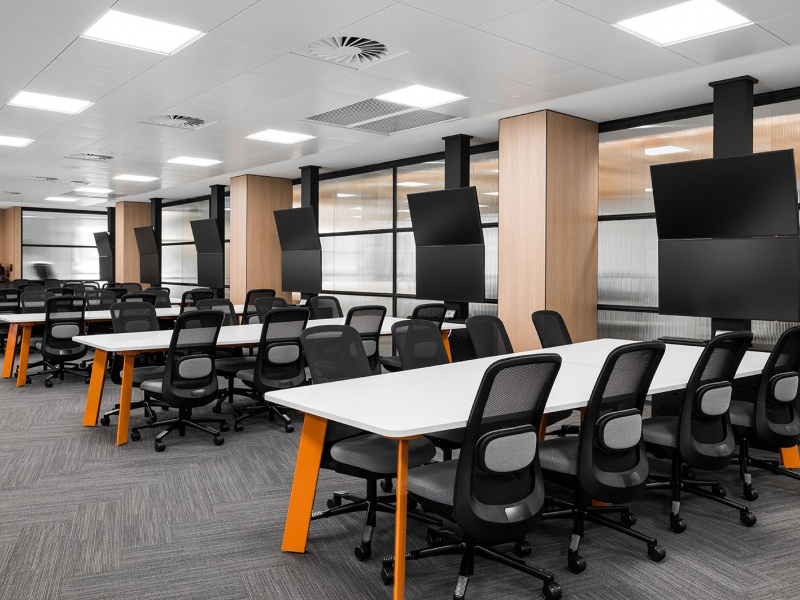
IP20 means that it can prevent solid objects of 12.5mm from entering the inside of the lamp tube, and at the same time prevent the lamp tube from being intruded by liquid when it is tilted at 15 Grad. If your lights are indoors and the space has a relatively neutral environment, then IP20 is fine. Lamps with this protection level can only be used in dry indoors, and the indoor environment should not have too much dust. Such as living room, Schlafzimmer, living room, office, school, supermarket, etc. LED lights with this protection level include LED downlights, LED panel lights, LED spotlights, led track lights, etc.
;
IP54 light and applications
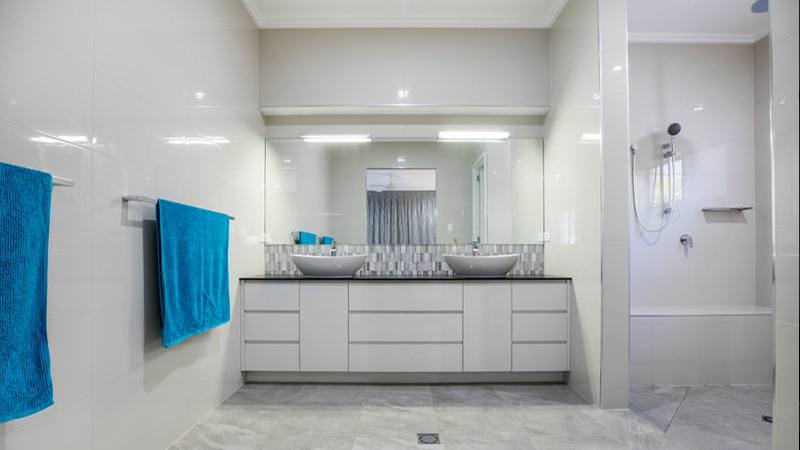
IP54 means that the adverse effects of dust-proof lamps can be ignored, and it is necessary to focus on its waterproof ability (to prevent damage to the lamp caused by water spraying into the lamp body from any direction). It is suitable for indoor humid environments, such as kitchens, bathrooms, toilets, Outdoor balcony. This kind of IP-rated lamps are usually designed on the basis of IP22 LED lamps, such as IP54 moisture-proof LED downlights, IP54 recessed ceiling lights, IP54 dust-proof light strips, etc.
;
IP65 waterproof light and its application

Starting from IP65, led lamps are now waterproof and can be used both outdoors and indoors. This rating means the lamp is dustproof so no solid objects can get inside. In terms of water, it can handle a 6.3mm nozzle, which means it should do well in the rain. Common IP65 waterproof led lights include outdoor landscape lights, outdoor flood lights, street lights, Wandfluter, LED bollard lights, etc.
;
IP66 waterproof light and its application
It’;s similar to IP65, but with higher water resistance. Protects the luminaire from high pressure water jets from any direction. Lamps are generally the same as IP65 types, such as buried lights, outdoor spotlights, usw., which are more waterproof, but they still cannot work underwater.
;
IP67 waterproof light and application
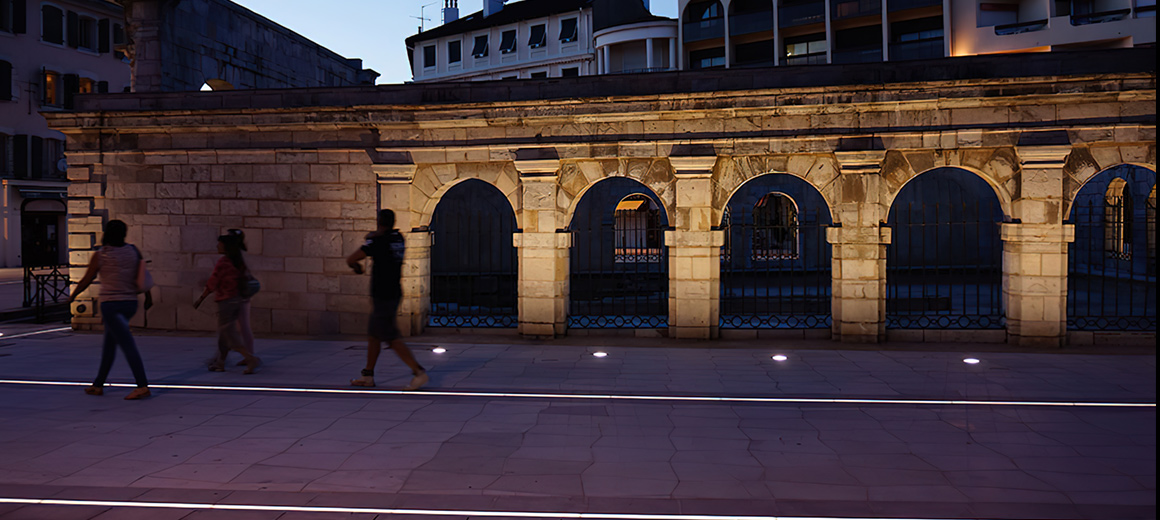
IP67 waterproof LED light can be submerged in water but for a short time, the depth is only 1 meter. Those lamps installed on the ground but close to the water are generally IP67, such as fountains on the ground, poolside, etc. In diesem Fall, the life of IP67 lamps will generally be longer. IP67 lights include inground lights, deck lights, etc.
;
IP68 waterproof light and application
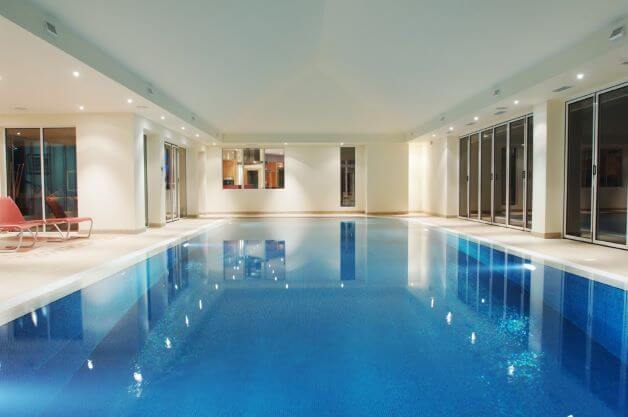
IP68 is the highest protection level in this protection system, if you need to put the light in the water more than one meter deep or stay in the water for more than ten minutes or so, you need a schwimmbad licht with IP68 protection level. Since it is installed underwater, the housing of this lamp is often made of 304 stainless steel to prevent rust and corrosion to the greatest extent. At the same time, the input voltage of the lamps is mostly AC/DC12V 24V input, which will be safer.
;
Fazit
You need to consider the specific environment in which the IP rated luminaires will be installed before choosing the right ones. This helps ensure that you choose the right IP rated luminaire. Zum Beispiel, IP54 can basically meet all requirements for indoor environments. Natürlich, if it is not a humid environment, then the most suitable option would be an IP22 lamp. These usually cost significantly less than an IP54 LED lamp. If the luminaires will be used outdoors, you need to consider whether or not they need to be installed underwater. If not, then an IP65-IP66 should be sufficient. If they will be submerged, then it is recommended to use an IP68 luminaire.
;
Lacelesty Lighting can help you when it comes to choosing the correct IP rating for the lights in your space.
;

